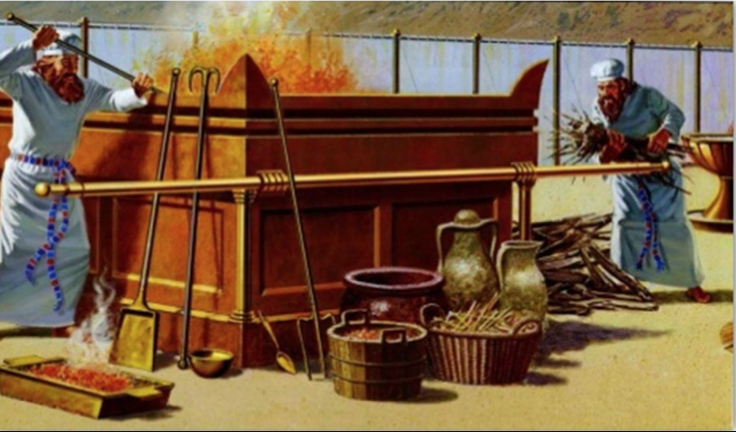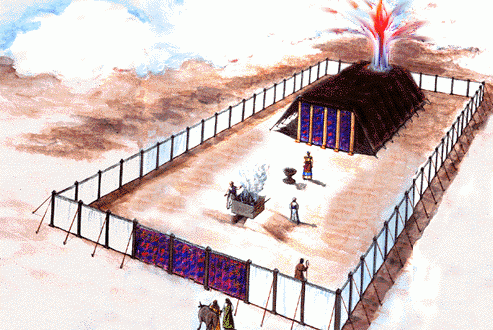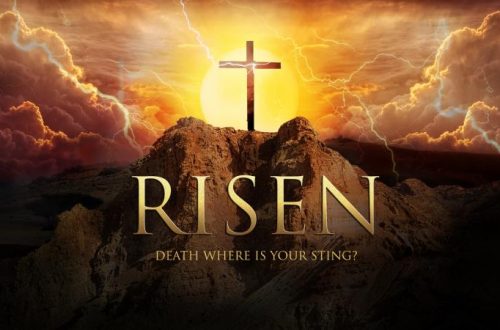
The Fire Sacrifices and Offerings of Israel – The Peace Offering
The Old Covenant Book of Leviticus outlines five special Levitical fire offerings and sacrifices. The Burnt Offering is for the sanctification of the whole man in self-surrender to the Lord, even unto death. The Meal Offering is the fruit of that sanctification. The Peace Offering is the blossoming of the possession and enjoyment of saving grace. The Sin Offering is for making amends for sin. The Trespass Offering was for the restoration of rights that had been violated.
The New Testament views all the old covenant sacrifices as types of the death of Christ. That is, the five sacrifices bring out different aspects and significance of His one sacrificial death on the cross. Lambs sacrificed every morning and evening were the most typical victim, so Jesus is called ‘the Lamb of God, who takes away the sin of the world (John 1:29). Indeed, he died at the time of the evening sacrifice. (3)
The Peace Offering (Leviticus 3:1-17)
The third Levitical offering is the Peace, Fellowship, or Communion Offering. The Hebrew name for the Peace Offering is zebach shlamim; literally, it means “sacrifices of peaces.” The second word, shlamim, comes from the well-known Hebrew word shalom, which means “peace” or “to make peace.” This was a voluntary thanksgiving offering. It emphasized complete well-being and harmony, not merely the absence of war. The uniqueness of this offering is that certain parts were burned on the Altar, providing a sweet-smelling aroma to God, but the rest was given back to the petitioner. That is the one who offered it got most of it back. This was the believer’s way of participating in the blessings of the fellowship or communion with God and the community via a shared ceremonial meal. (2)
The Old Testament idea of peace (shalom) had ethical considerations of completeness, wellness, prosperity, friendship, and happiness. The peace offerings (shelamin) had the right relations or harmony as their basic thought. The prominent and distinct feature of the ritual of the peace offering was the common meal afterward, signifying peace with God, who was personified in His representative, the Levitical priest (Lev 7:15). The prophet, using the peace offering as a thing that will contrast and complement, spoke of Israel’s millennial bliss as “the work of righteousness will be peace” (Isaiah 32:17). (5)
The Peace Offering is not mentioned explicitly in the New Covenant. Implicitly, it is found in Acts 21:23–26, which deals with offerings at the conclusion of a vow, and the Peace Offering in its votive form would be used for that purpose.
Peace Offering Occasions
Private
Voluntary Offering of two forms, either as a:
- Thanksgiving offering (thanksgiving and confessional offering) in Leviticus 7:12–14; 22:29, and it is almost synonymous with the fellowship offerings of 2 Chronicles 29:31; 33:16; and Jeremiah 17:26. It was brought as an acknowledgment of God’s deliverance or blessing bestowed as an answer to prayer (Psalms 56:12–13; 107:22; 116:17-19; Jeremiah 33:11). This offering also included cakes of unleavened and leavened bread shared with the officiating priest. (Leviticus 7:12–14 NET) or
- Freewill offering (a spontaneous freewill offering) (Psalms 54:6) to express devotion and thanksgiving to God for some unexpected blessing (Leviticus 7:16 and 22:17–20).
Required Offering in one form:
- Votive Offering (i.e., offered or consecrated in fulfillment of a vow) individual offering for the fulfillment of a vow (Leviticus 7:12, 16. Psalms 56:12,13). It was regularly preceded by a Burnt Offering (Leviticus 3:5). It was a ritual expression of a vow in Leviticus 27:9–10. When a Nazirite fulfilled his vow, this is the sacrifice he would need to offer according to Numbers 6:17–20.
Public
Required offering in two forms:
- Ordination of a priest (Leviticus 9:4)
- Mandatory during the Feast of Weeks (Leviticus 23:19) (see “Sacrifices and Offerings of the Old Covenant” table later in this article).
Required Sacrifices
The animal to be sacrificed had to have the following four general characteristics. The animal had to be:
- ceremonially clean,
- utilitarian, meaning “usable for food” or sustenance,
- domesticated (i.e., those that obeyed their master’s will; although some wild game animals were permissible for food, no game animal was permissible for sacrifice), and
- costly; the selection of the animal was based upon the economic status of the individual Jewish member of the commonwealth.
If the individual were wealthy, he had to offer an expensive sacrifice; if he were poor, he could offer a less expensive sacrifice; nevertheless, it would have to be costly relative to his economic status. As Moses deals with the specific animals allowed, the progression always goes from the most expensive to the least expensive as follows:
- Bull
- Cow
- Male sheep or goat
- Female sheep or goat
The kinds of animals for the Peace Offering and the details of how they were offered closely parallel the Burnt Offering. (see “Sacrifices and Offerings of the Old Covenant” table immediately below)

In addition, the animal to be sacrificed had to meet the following three criteria:
- Condition – perfect without spot, blemish, disease, or deformity,
- Gender – Male or Female (4), and
- Age – generally, the animal had to be one year old [e.g., a lamb at the peak of life and health]. Sometimes it could be as young as eight days old (Leviticus 22:27) or as old as three years (Genesis 15:9). (2)
Again, any male or female animal from flocks such as sheep and goats and herds of cattle without blemish were used based on the social status of the offerer, but not birds. Birds were not allowed for a Peace Offering, because a bird would not provide sufficient meat for a full, festive meal. (4)
Required Grain Offering
Thanksgiving Peace Offering
When offered as a thanksgiving offering, it was accompanied by a Grain offering (1) without leaven (i.e., yeast) and containing olive oil (1):
If he presents it on account of thanksgiving, along with the thank offering sacrifice he must present unleavened loaves mixed with olive oil, unleavened wafers smeared with olive oil, and well soaked ring-shaped loaves made of choice wheat flour mixed with olive oil. (Leviticus 7:12 NET)
In addition, bread made with yeast (1) was a prescribed part of this offering. This is one of the two times that leaven is part of an offering, the other is the Two Loaves of the First Fruit of Wheat during the Feast of Weeks (1) (Feast of Pentecost) (Leviticus 23:17).
He must present this grain offering in addition to ring-shaped loaves of leavened bread which regularly accompany the sacrifice of his thanksgiving peace offering. (Leviticus 7:13 NET)
However, the Leavened bread never to contact with blood and is not offered on the Brazen Altar.
“You must not offer the blood of my sacrifice with bread containing yeast; the fat of my festal sacrifice must not remain until morning. (Exodus 23:18 NET)(cf. Exodus 34:25)
There were eight sequential steps of the Peace Offering ritual.
- The worshipper brought the animal to the entrance of the tent of meeting.
- The worshipper pressed his hands on the animal’s head.
- The worshipper killed the animal.
- The priest would splash the animal’s blood over and around the Bronze Altar.
- The worshipper would butcher the animal.
- Parts of the animal were salted (1) and then burned on the Altar by the priest, providing a sweet-smelling aroma to God. (This included the kidneys, which were the symbol of one’s emotions (Job 19:27), and the fat, including the liver’s fatty lobe, which symbolized the best of the offering; the best was given to God according to Genesis 45:18. Furthermore, Israelites were forbidden to eat any fat or blood (Leviticus 3:17)).
- The priest was entitled to keep certain parts of the animal: the skin, the right thigh or shoulder (to the officiating priest), and the breast (to all other priests). (Deuteronomy 12:12. 1 Corinthians 9:13,14)
“This portion of the peace offerings was strictly defined and might not be altered or exceeded. As we learn from Leviticus 7:28-36, the legal due was the breast, brisket, and right shoulder. [The right thigh or shoulder typifies the power and strength of the Messiah.] These were solemnly dedicated to the Lord (the former by being “waved (1),” that is, moved repeatedly in a presentation to the Saviour and Preserver on earth; the latter, by being “heaved (1),” or once lifted up, to the Intercessor in heaven), and were then made over to the priests.” (9)
“[Again,] …the right shoulder, considered the choicest part of the victim, was to be “heaved,” and viewed as holy to the Lord, only eaten therefore by the priest; the breast was to be “waved,” and eaten by the other priests.”(6)“But before this was done, the fat had to be burned upon the altar, which was the appointed way of consecrating the whole sacrifice, and no portion could be lawfully appropriated till this rite was performed. The fat, or suet (for the rule referred only to the pure, internal fat, not to that which was mixed with the flesh), was thus offered, not simply because it was the most combustible part of the carcass, but because it was regarded as the best portion, the plain token of a perfect and well-nourished body. And as being God’s share, it was never to be eaten; upon its use, the same restriction was laid as upon blood (Leviticus 3:17), with this difference, that, whereas the eating of blood was forbidden under all circumstances, the interdict on the consumption of fat applied only to animals sacrificed, or to such as were capable of being sacrificed.” (9) (See The Women of the Tabernacle (1) for a case where this requirement was violated repeatedly by Eli’s two sons resulting in their deaths) - The worshipper, his family, their servants, Levites, and the poor ate the remainder of the sacrifice (i.e., except for the “heave shoulder,” the wave breast,” and the fat that was burned) as a festive meal (Deuteronomy 12:18;16:11) under certain restrictions (Leviticus 7:19-21). If it were a thanksgiving or confessional offering, it was eaten the same day. If it were offered for other reasons, it was eaten the following day. All who ate it had to be ceremonially clean, and all leftovers had to be completely burned.
Typological Meaning
The Peace Offering typifies the value of the Messiah’s death in terms of its communion. It typifies the Messiah’s procuring peace with God for the sinner (Romans 5:1).
Therefore, since we have been declared righteous by faith, we have peace with God through our Lord Jesus Christ, (Romans 5:1 NET)
I have told you these things so that in me you may have peace. In the world you have trouble and suffering, but take courage—I have conquered the world.” (John 16:33 NET)
In addition, it typifies the fellowship of believers with God, once again, the concept of communion.
What we have seen and heard we announce to you too, so that you may have fellowship with us (and indeed our fellowship is with the Father and with his Son Jesus Christ). Thus we are writing these things so that our joy may be complete. (1 John 1:3,4 NET)
Sacrifices and Offerings of the Old Covenant Series:
- The Fire Sacrifices and Offerings of Israel – Introduction
- The Fire Sacrifices and Offerings of Israel – The “Whole” Burnt Offering
- The Fire Sacrifices and Offerings of Israel – The Meal Offering
- The Fire Sacrifices and Offerings of Israel – The Peace Offering
- The Fire Sacrifices and Offerings of Israel – The Sin Offering
- The Fire Sacrifices and Offerings of Israel – The Trespass Offering
- The Fire Sacrifices and Offerings of Israel – The Red Heifer Offering
- The Fire Sacrifices and Offerings of Israel – The Ordination Offering
Biblical Typologies, Metaphors, & Similes Series:
- The Old Leaven of the Kingdom of Darkness
- The New Leaven of the Kingdom of Heaven
- Wine
- Water
- Finely Sifted (Wheat) Flour
- Frankincense
- Myrrh
- Anointing Oil
- Olive Oil
- Honey
- Salt
- Waving and Heaving
- Barley
- Gold
- Silver
- Bronze
- Stone
- Wood
- Linen
- Iron
- Shofar and Trumpet
Shalom
(Security, Wholeness, Success)
Peace
Then he said to them, “Therefore every expert in the law who has been trained for the kingdom of heaven is like the owner of a house who brings out of his treasure what is new and old.” (Matthew 13:52 NET)
(1) Select the link to open another article with additional information in a new tab.
(2) This article has been primarily adapted from: Fruchtenbaum, A. G. (1983). The Messianic Bible Study Collection (Vol. 180, p. 16). Tustin, CA: Ariel Ministries.
(3) Wenham, G. J. (1981). Numbers: an introduction and commentary (Vol. 4, p. 220). Downers Grove, IL: InterVarsity Press.
(4) The male animal represents this sacrifice is for God’s benefit. Recall, Adam, a male, was made for God’s benefit.
“It follows that I show for what purpose God made man himself. As He contrived the world for the sake of man, so He formed man himself on His own account, as it were a priest of a divine temple, a spectator of His works and of heavenly objects. For he is the only being who, since he is intelligent and capable of reason, is able to understand God, to admire His works, and perceive His energy and power; for on this account he is furnished with judgment, intelligence, and prudence. On this account he alone, beyond the other living creatures, has been made with an upright body and attitude, so that he seems to have been raised up for the contemplation of his Parent. On this account he alone has received language, and a tongue the interpreter of his thought, that he may be able to declare the majesty of his Lord. Lastly, for this cause all things were placed under his control, that he himself might be under the control of God, their Maker and Creator. If God, therefore, designed man to be a worshipper of Himself, and on this account gave him so much honour, that he might rule over all things; it is plainly most just that he should worship Him who bestowed upon him such great gifts, and love man, who is united with us in the participation of the divine justice.”
Lactantius. (1886). A Treatise on the Anger of God. In A. Roberts, J. Donaldson, & A. C. Coxe (Eds.), W. Fletcher (Trans.), Fathers of the Third and Fourth Centuries: Lactantius, Venantius, Asterius, Victorinus, Dionysius, Apostolic Teaching and Constitutions, Homily, and Liturgies (Vol. 7, p. 271). Buffalo, NY: Christian Literature Company.
Eve, a female, was made for the man Adam’s benefit and hence when female animals are prescribed in sacrifices then it is for mankind’s benefit.
The Lord God said, “It is not good for the man to be alone. I will make a companion for him who corresponds to him.” (Genesis 2:18 NET)
(5) McCune, R. (2009). A Systematic Theology of Biblical Christianity: The Doctrines of Man, Sin, Christ, and the Holy Spirit (Vol. 2, p. 193). Allen Park, MI: Detroit Baptist Theological Seminary.
(6) Intentionally Blank
(7) Easton, M. G. (1893). In Easton’s Bible dictionary. New York: Harper & Brothers.
(8) Hamilton, M. W. (2000). Elevation Offering. In D. N. Freedman, A. C. Myers, & A. B. Beck (Eds.), Eerdmans dictionary of the Bible (p. 392). Grand Rapids, MI: W.B. Eerdmans.
(9) Deane, W. J. (1889). Samuel and Saul: Their Lives and Times (pp. 21–22). New York: Anson D. F. Randolph & Company.
(10) Freeman, J. M., & Chadwick, H. J. (1998). Manners & customs of the Bible (p. 148). North Brunswick, NJ: Bridge-Logos Publishers.
(I) Neusner, J. (1988). The Mishnah : A new translation (p. 742). New Haven, CT: Yale University Press.
(II) Malda, B. D. (Ed.). (2015). Come and Worship: Ways to Worship from the Hebrew Scriptures (p. 62). Clarksville, MD: Lederer Books: a division of Messianic Jewish Publishers.
(III) Sklar, J. (2013). Leviticus: An Introduction and Commentary. (D. G. Firth, Ed.) (Vol. 3, p. 101). Nottingham, England: Inter-Varsity Press.
(IV) Masterman, E. W. G. (1915). Barley. In J. Orr, J. L. Nuelsen, E. Y. Mullins, & M. O. Evans (Eds.), The International Standard Bible Encyclopaedia (Vol. 1–5, p. 405). Chicago: The Howard-Severance Company.
(V) Balfour, J. H. (1885). The Plants of the Bible (p. 212). London; Edinburgh; New York: T. Nelson and Sons.
(VI) Eisenberg, R. L. (2004). The JPS guide to Jewish traditions (1st ed., p. 670). Philadelphia: The Jewish Publication Society.
(VII) Hannah, J. D. (1985). Exodus. In J. F. Walvoord & R. B. Zuck (Eds.), The Bible Knowledge Commentary: An Exposition of the Scriptures (Vol. 1, p. 153). Wheaton, IL: Victor Books.
(VIII) Easton, M. G. (1893). In Easton’s Bible dictionary. New York: Harper & Brothers.
(IX) Singer, I. (Ed.). (1901–1906). In The Jewish Encyclopedia: A Descriptive Record of the History, Religion, Literature, and Customs of the Jewish People from the Earliest Times to the Present Day, 12 Volumes (Vol. 9, p. 568). New York; London: Funk & Wagnalls.
(X) Hamilton, M. W. (2000). Elevation Offering. In D. N. Freedman, A. C. Myers, & A. B. Beck (Eds.), Eerdmans dictionary of the Bible (p. 392). Grand Rapids, MI: W.B. Eerdmans.
(XI) (2016). The Lexham Figurative Language of the New Testament Dataset. In J. R. Westbury, J. Thompson, K. A. Lyle, & J. Parks (Eds.), Lexham Figurative Language of the Bible Glossary. Bellingham, WA: Lexham Press.
(XII) Larson, K. (2000). I & II Thessalonians, I & II Timothy, Titus, Philemon (Vol. 9, p. 331). Nashville, TN: Broadman & Holman Publishers.
(XIII) Lindsey, F. D. (1985). Leviticus. In J. F. Walvoord & R. B. Zuck (Eds.), The Bible Knowledge Commentary: An Exposition of the Scriptures (Vol. 1, p. 177). Wheaton, IL: Victor Books.
(XIV) Neusner, J. (2011). The Babylonian Talmud: A Translation and Commentary (Vol. 19, p. 617). Peabody, MA: Hendrickson Publishers.
(XV) Freeman, J. M., & Chadwick, H. J. (1998). Manners & customs of the Bible (p. 143). North Brunswick, NJ: Bridge-Logos Publishers.
(XVI) Wuest, K. S. (1961). The New Testament: an expanded translation (1 Co 5:6–8). Grand Rapids, MI: Eerdmans.
(XVII) Thompson, J. A. (1974). Deuteronomy: An Introduction and Commentary (Vol. 5, p. 147). Downers Grove, IL: InterVarsity Press.
(XVIII) Keach, B. (1858). An Exposition of the Parables and Express Similitudes of Our Lord and Saviour Jesus Christ(pp. 239–240). London: Aylott and Co.
(XIX) Beis Hamikdash Topics – Tour of the Temple: Class 10, The Altar
(XX) C. S. Lewis, Miracles (New York: HarperCollins, 1974), pp. 236–37.
(XXI) Hall, K. D. (2000). Libation. In D. N. Freedman, A. C. Myers, & A. B. Beck (Eds.), Eerdmans dictionary of the Bible (p. 807). Grand Rapids, MI: W.B. Eerdmans.
(XXII) Rogers, A. (2017). Back to Bethel. In Adrian Rogers Sermon Archive (Ge 35). Signal Hill, CA: Rogers Family Trust.
(XXIII) Ryrie, C. C. (1999). Basic Theology: A Popular Systematic Guide to Understanding Biblical Truth (p. 341). Moody Press.
Propitiation, as we have seen, means the placating or satisfying of the personal wrath of God. Expiation is the removal of impersonal wrath, sin, or guilt. Expiation has to do with reparation for a wrong; propitiation carries the added idea of appeasing an offended person and thus brings into the picture the question of why the offended person was offended. In other words, propitiation brings the wrath of God into the picture, while expiation can leave it out.




